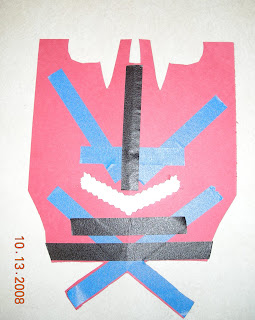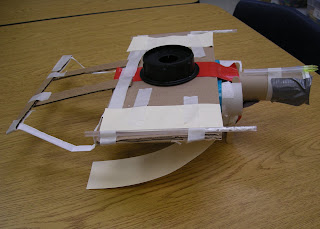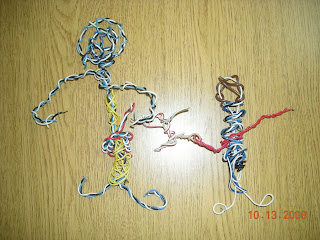Sunday, January 25, 2009
Construction Station
At the Construction Station, students find a variety of materials for creating three-dimensional sculptures: cardboard, bottle caps, marker lids, prescription bottles, yogurt containers, frozen food containers, wire, and various other found objects. These can be connected with slotted construction, L-tabs, glue, wire, and moderate uses of tape.
Labels:
bottle caps,
cardboard,
cardboard boxes,
choice,
creativity,
glue,
paper tape,
plastic lids,
sculpture,
string,
tape,
wire
Wire Sculptures
This year I was able to rescue a lot of colored wire when our building got new light fixtures. The students have enjoyed creating figures with the wire. Some of them have added a wire figure to existing cardboard constructions.
Paper Station
At the paper station there are a wide variety of materials to use: construction paper, gift wrap paper, tissue paper, animal print paper, patterned paper from several different cultures, gold and silver paper, doilies, scrap yarn, craft sticks, stickers, foam shapes, and a variety of shapes left when making cosmetic and candy boxes at a professional packaging company. These can be torn, or cut with regular scissors or scissors that make decorative edges. They can be attached with glue, staples, and colored tape. They can be attached to white paper, colored paper, paper bags, or paper plates. They can be used to create collages, masks, puppets, or paper sculptures.
The following are some creations from our paper station.
The following are some creations from our paper station.
Robbie's Castle
Robbie is a 5th Grade student who has been drawing castles with battles for several years and showing improvement in skills on each one, demonstrating the value of a choice-based class in which the art room is run like a studio where the artist (student) makes their own choice of subject matter.
Saturday, January 24, 2009
Drawing Station
Our drawing station has many materials for use by students: pencils, pens, sharpie markers, colored pencils, crayons, glitter crayons, construction paper crayons for use on colored paper, and oil pastels. There are texture sheets for creating rubbings of a variety of textures. There are objects to draw, such as toy vehicles, dinosaurs, and fantasy creatures. There is a large photo reference file. There are many drawing books. There is a still life set-up of objects to draw such as vases, flowers, and stuffed animals.
The following pictures are ones done with drawing station materials.
The following pictures are ones done with drawing station materials.
National Standards for Art Education
These are the National Standards for Art Education, and the way that they are followed in a choice-based art room:
Content Standard #1: Understanding and applying media,techniques, and processes
With six to nine stations operating at a time, demonstrations of materials and techniques given at each one, and the opportunity to experiment at each one, the students become versed in more varieties of materials, techniques, and processes than in a traditional project-based art classroom setting.
Content Standard #2: Using knowledge of structures and functions
This content is covered at the cardboard construction station, where three-dimensional found-object sculpture can be created with movable parts.
Content Standard #3: Choosing and evaluating a range of subject matter, symbols, and ideas
The choice-based classroom allows the student to choose his or her subject matter and evaluate the best way to present that subject matter to his or her audience.
Content Standard #4: Understanding the visual arts in relation to history and cultures
In five-minute demonstrations at the beginning of each class, multiple cultures and historical masters in art can be presented.
Content Standard #5: Reflecting upon and assessing the characteristics and merits of their work and the work of others
We discuss the importance of reflecting on one's work in order to continually improve and grow. Students in second grade through fifth grade write a statement about their artwork every time that they finish a work. Third grade through fifth grade students keep all work in a portfolio, which is used by the teacher for assessment, and by the student and teacher together twice a year. The work of master artists is viewed and discussed frequently.
Content Standard #6: Making connections between visual arts and other disciplines
With individuals, I discuss how the problem-solving done in each art work transfers to learning in their other subjects. With whole groups, we discuss how the skills used in the art room transfer to math, science, cultural learning in social studies, writing, and everyday lives.
Content Standard #1: Understanding and applying media,techniques, and processes
With six to nine stations operating at a time, demonstrations of materials and techniques given at each one, and the opportunity to experiment at each one, the students become versed in more varieties of materials, techniques, and processes than in a traditional project-based art classroom setting.
Content Standard #2: Using knowledge of structures and functions
This content is covered at the cardboard construction station, where three-dimensional found-object sculpture can be created with movable parts.
Content Standard #3: Choosing and evaluating a range of subject matter, symbols, and ideas
The choice-based classroom allows the student to choose his or her subject matter and evaluate the best way to present that subject matter to his or her audience.
Content Standard #4: Understanding the visual arts in relation to history and cultures
In five-minute demonstrations at the beginning of each class, multiple cultures and historical masters in art can be presented.
Content Standard #5: Reflecting upon and assessing the characteristics and merits of their work and the work of others
We discuss the importance of reflecting on one's work in order to continually improve and grow. Students in second grade through fifth grade write a statement about their artwork every time that they finish a work. Third grade through fifth grade students keep all work in a portfolio, which is used by the teacher for assessment, and by the student and teacher together twice a year. The work of master artists is viewed and discussed frequently.
Content Standard #6: Making connections between visual arts and other disciplines
With individuals, I discuss how the problem-solving done in each art work transfers to learning in their other subjects. With whole groups, we discuss how the skills used in the art room transfer to math, science, cultural learning in social studies, writing, and everyday lives.
Oklahoma P.A.S.S. objectives
These are the Priority Academic Student Skills for Art for grade three in Oklahoma. They vary slightly for grades above and below this grade level in age appropriate requirements.
Standard 1: Language of Visual Art - The student will identify visual art terms (e.g., collage, design, original, portrait, paint, subject).
Standard 2: Visual Art History and Culture - The student will recognize the development of visual art from an historical and cultural perspective.
Many master artists from other cultures, as well as from a historical standpoint, are presented and discussed. Since there is a five-minute demo every class period, rather than a repetition of instructions for a project, there is much more time to introduce a wide-variety of artists, history, and cultures.
Standard 3: Visual Art Expression - The student will observe, select, and utilize a variety of ideas and subject matter in creating original works of visual art.
How can a student select subject matter in a traditional classroom where projects are selected by the teacher? How can a lesson taught by a teacher be considered original works of art? In a choice-based classroom, the art room is a studio, and the student is treated as an authentic artist who makes their own selections of subject matter and materials
Standard 4: Visual Art Appreciation - The student will appreciate visual art as a vehicle of human expression.
Many prints are displayed in the classroom, as well as the work of current and previous students. Many of discussion questions asked are about these works of art, displaying the students' appreciation for and interest in these works.
Standard 1: Language of Visual Art - The student will identify visual art terms (e.g., collage, design, original, portrait, paint, subject).
These and other terms are used in five-minute demos at the beginning of each class. We have two word walls with pertinent vocabulary words and material terms, as well as color, shape, form, and texture words The use of these words is pointed out frequently.
Standard 2: Visual Art History and Culture - The student will recognize the development of visual art from an historical and cultural perspective.
Many master artists from other cultures, as well as from a historical standpoint, are presented and discussed. Since there is a five-minute demo every class period, rather than a repetition of instructions for a project, there is much more time to introduce a wide-variety of artists, history, and cultures.
Standard 3: Visual Art Expression - The student will observe, select, and utilize a variety of ideas and subject matter in creating original works of visual art.
How can a student select subject matter in a traditional classroom where projects are selected by the teacher? How can a lesson taught by a teacher be considered original works of art? In a choice-based classroom, the art room is a studio, and the student is treated as an authentic artist who makes their own selections of subject matter and materials
Standard 4: Visual Art Appreciation - The student will appreciate visual art as a vehicle of human expression.
Many prints are displayed in the classroom, as well as the work of current and previous students. Many of discussion questions asked are about these works of art, displaying the students' appreciation for and interest in these works.
Monday, January 19, 2009
Subscribe to:
Posts (Atom)

























